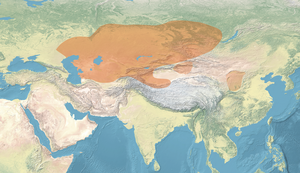General location of the Subeshi culture, next to the Saka realm ( ), and contemporary Asian polities c. 325 BCE | |
| Geographical range | Turpan, Xinjiang, China |
|---|---|
| Dates | 1100–100 BCE |
| Preceded by | Chemurchek culture |
| Followed by | Jushi Kingdom, Xiongnu |
The Subeshi culture (simplified Chinese: 苏贝希文化; traditional Chinese: 蘇貝希文化; 1100–100 BCE), also rendered as Subeishi culture or Subeixi culture, is an Iron Age culture from the area of Shanshan County, Turfan, Xinjiang, at the eastern edge of the Tarim Basin.[1] The Subeshi culture contributes some of the later period Tarim Mummies. It might be associated with the Jushi Kingdom known from Chinese historical sources.[2][1] The culture includes three closely related cemeteries:
- the Subeshi cemetery
- the Shengjindian cemetery,[1]
- the Yanghai cemetery.[3]
After 200 BCE, the Subeshi culture may have evolved into the later walled city-state culture of the Jushi Kingdom.[4]
- ^ a b c Zhang, Kai (4 February 2021). "The Spread and Integration of Painted pottery Art along the Silk Road". Region – Educational Research and Reviews. 3 (1): 18. doi:10.32629/RERR.V3I1.242. S2CID 234007445.
In the late Neolithic period and the early Bronze age, pottery, ornamentation and bronze culture with the characteristics of West Asia and Central Asia were introduced into Xinjiang, including Qijia culture (2500–1500 BC), Siba culture (about 2000–1600 BC), Chawuhugoukou culture (around 800–100 BC), Turpan Subeixi culture (1100 BC–100 BC) and other cultures.
- ^ Beck, Ulrike; Wagner, Mayke; Li, Xiao; Durkin-Meisterernst, Desmond; Tarasov, Pavel E. (20 October 2014). "The invention of trousers and its likely affiliation with horseback riding and mobility: A case study of late 2nd millennium BC finds from Turfan in eastern Central Asia". Quaternary International. 348: 225–226. Bibcode:2014QuInt.348..224B. doi:10.1016/j.quaint.2014.04.056. ISSN 1040-6182.
The Yanghai graveyard is assigned to the Subeixi (Subeshi) culture (e.g. Jiang et al., 2006, 2009), conventionally dated to the first millennium BC (Chen, 2002; Han, 2007; Xinjiang, 2011). The culture is associated with the Cheshi (Chü-shih) state known from Chinese historical sources (Sinor, 1990).
- ^ Jiang, Hongen; Li, Cheng-Sen; Cao, Hongyong; Shading, Palidanmu; Cheng, Ye-Ming (July 2021). "Wood Utilization During the Late Bronze to Early Iron Age in the Turpan Basin of Xinjiang, China, With Special Emphasis on Betula (Betulaceae)". SAGE Open. 11 (3): 215824402110469. doi:10.1177/21582440211046950. ISSN 2158-2440.
- ^ Lan-Hai Wei, Ryan; Li, Hui; Xu, Wenkan (26–28 June 2013). "The separate origins of the Tocharians and the Yuezhi: Results from recent advances in archaeology and genetics". Conference: International Conference on Tocharian Manuscripts and Silk Road Culture At: University of Vienna, Vienna: 285.
In the Turpan Basin area after 200 B.C., the Subeishi culture developed into the local walled nation-state called the Gushi Kingdom.

